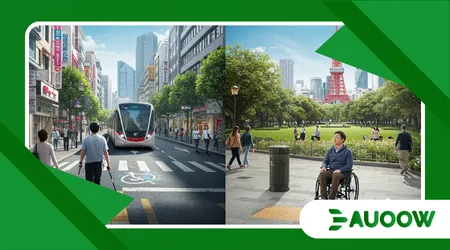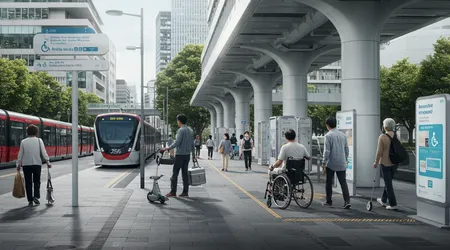Accessible Cities 2025: Which Countries Are Leading the Way?

Accessible Cities 2025 represent a bold vision where urban spaces prioritize inclusivity, ensuring everyone navigates with ease.
As populations diversify and awareness of disability rights grows, cities worldwide are reimagining infrastructure, technology, and policies to foster universal access.
This isn’t just about ramps or braille signs it’s about creating environments where all citizens thrive. From Tokyo’s high-tech solutions to Copenhagen’s human-centered designs, the race to build truly inclusive cities is on.
Which nations are setting the pace, and what can we learn from them? This exploration dives into the leaders, their strategies, and why Accessible Cities 2025 matter now more than ever.
The push for accessibility reflects a deeper societal shift. Urban populations are aging by 2030, 1.4 billion people will be over 60, per the UN. Meanwhile, over 1 billion people live with disabilities globally.
Cities that ignore these realities risk alienating millions. Accessibility isn’t a luxury; it’s a necessity for economic and social vitality.
Leading countries are blending innovation, policy, and community input to redefine urban living. Let’s unpack how Japan, Denmark, and Canada are shaping Accessible Cities 2025, with lessons for the world.
Japan: Technology Meets Tradition
Japan’s commitment to Accessible Cities 2025 is a masterclass in blending cutting-edge tech with cultural respect. Tokyo, a global megacity, leads with innovations like piezoelectric tiles in Shibuya, generating electricity from footsteps while ensuring smooth, tactile pathways for visually impaired pedestrians.
These tiles aren’t just eco-friendly; they signal a city designed for all. Japan’s aging population nearly 30% over 65 drives this focus, pushing universal design to the forefront.
Public transport shines here. Tokyo’s metro system offers braille maps, audio announcements, and platform edge barriers.
Stations like Shinjuku, handling millions daily, prioritize seamless navigation. Imagine a visually impaired commuter gliding through a bustling station, guided by tactile paving and clear audio cues. It’s not perfect crowds can overwhelm but it’s a model of intentional design.
++ Beyond Quick Fixes: Building Genuine Inclusive Experiences in Daily Digital Accessibility
Beyond hardware, Japan’s policies enforce accessibility. The 2018 Barrier-Free Law mandates retrofitting public spaces. Local governments collaborate with disability advocates to ensure compliance.
This isn’t just top-down; community feedback shapes solutions, like apps guiding wheelchair users to accessible routes. Japan’s approach asks: why can’t technology make every corner of a city inclusive?
Yet challenges persist. Rural areas lag behind urban hubs, and small businesses often struggle with retrofit costs. Japan counters this with subsidies and public-private partnerships, ensuring accessibility isn’t an urban-only privilege.
By 2025, Japan aims for 90% of public facilities to meet universal design standards, a benchmark for Accessible Cities 2025.

Denmark: Human-Centered Urban Design
Denmark’s pursuit of Accessible Cities 2025 hinges on human-centered urban planning. Copenhagen, often hailed as a livability icon, integrates accessibility into its DNA.
The city’s bike lanes, for instance, aren’t just for cyclists they’re wide, smooth, and equipped with tactile markers for visually impaired pedestrians. This dual-purpose infrastructure maximizes inclusivity.
Public spaces reflect this ethos. The Royal Danish Library’s ramps and adjustable desks cater to diverse needs. Copenhagen’s “City for All” initiative engages residents with disabilities in planning.
Picture a wheelchair user helping design a park’s pathways Denmark makes this real. Engagement ensures solutions aren’t just theoretical but practical.
Data backs Denmark’s success. A 2024 European Accessibility Report noted Copenhagen’s public transport as 95% accessible, topping EU rankings.
Read more: How to Make Shared Bathrooms Accessible Without Major Renovations
This stems from policies like the 2020 Accessibility Act, mandating inclusive design in new infrastructure. Denmark’s focus isn’t flashy tech but intuitive, people-first solutions.
Still, affordability remains a hurdle. Retrofitting older buildings strains municipal budgets. Denmark tackles this through phased upgrades and tax incentives for private owners.
Another challenge? Ensuring accessibility doesn’t compromise aesthetics. Copenhagen’s sleek, functional designs prove both can coexist, setting a global standard for Accessible Cities 2025.
Community-driven innovation is key. Local workshops train architects in universal design principles. Meanwhile, apps like AccessMap, tailored for Copenhagen, help users navigate accessible routes. Denmark’s lesson? Accessibility thrives when people, not just policies, drive change.
Canada: Policy and Community Synergy
Canada’s approach to Accessible Cities 2025 blends robust policy with grassroots advocacy. Toronto and Vancouver lead, driven by the 2021 Accessible Canada Act, which mandates barrier-free public spaces by 2040. This long-term vision starts now, with cities like Toronto retrofitting subway stations for full accessibility.
Vancouver’s pedestrian-friendly downtown core features curb cuts, tactile paving, and audible crosswalk signals.
Consider a visually impaired person crossing Granville Street, guided by clear audio cues this is Canada’s commitment in action. The city’s 2025 Accessibility Strategy emphasizes community input, ensuring policies reflect real needs.
Read more: Is Your Neighborhood Walkable for People with Disabilities?
A 2023 Canadian Urban Institute study found 80% of Vancouver’s public buildings meet WCAG guidelines, a strong foundation. Canada’s strength lies in collaboration municipalities, NGOs, and disability groups co-create solutions.
For example, Toronto’s Accessibility Advisory Committee includes residents with disabilities, shaping projects like the Eglinton Crosstown LRT.
Challenges include inconsistent implementation across provinces. Rural areas, like in Japan, lag behind. Canada addresses this with federal funding for smaller municipalities.
Another hurdle? Training staff to maintain accessibility standards. Toronto’s ongoing workshops for transit workers show progress.
Canada also leverages tech. Apps like AccessNow map accessible venues, empowering users. This synergy of policy, community, and innovation positions Canada as a leader in Accessible Cities 2025, proving inclusivity starts with listening.
The Role of Technology in Accessible Urban Futures
Technology is a game-changer for Accessible Cities 2025, but it’s not a cure-all. Smart cities like Singapore use AI-driven apps to guide visually impaired pedestrians via real-time audio.
Sensors in crosswalks adjust signal times for slower walkers, a small tweak with big impact. Yet tech must be intuitive, not overwhelming.
Augmented reality (AR) is emerging as a tool. In London, AR apps overlay navigation cues for wheelchair users, highlighting ramps or elevators.
But high costs and digital literacy gaps limit adoption. Cities must balance innovation with simplicity complex apps alienate those they aim to help.
| City | Key Technology | Accessibility Impact |
|---|---|---|
| Tokyo | Piezoelectric tiles, braille apps | Energy-efficient paths, navigation ease |
| Singapore | AI navigation, smart crosswalks | Real-time guidance, safer crossings |
| London | AR accessibility apps | Enhanced route planning for mobility issues |
Tech’s downside? Overreliance risks neglecting low-tech solutions like clear signage. Cities must integrate both, ensuring no one’s left behind. The question isn’t just about gadgets it’s about who they serve and how.
Open-source platforms are gaining traction. In 2025, initiatives like AccessMap expand globally, crowdsourcing accessibility data.
Cities adopting these tools empower communities to map their own needs. Technology, when inclusive, amplifies human potential, not just infrastructure.
Global Lessons and the Path Forward
The race for Accessible Cities 2025 reveals a truth: accessibility is a mindset, not a checklist. Japan’s tech-driven precision, Denmark’s human-first designs, and Canada’s policy-community synergy offer distinct blueprints.
Each excels by prioritizing users whether through tactile paving, inclusive planning, or apps.
Yet gaps remain. Rural-urban divides, funding shortages, and inconsistent standards challenge progress. The solution? Cross-country learning.
Japan’s subsidies could inspire Canada’s rural upgrades. Denmark’s community workshops could enhance Tokyo’s urban focus. Collaboration is the key to scaling success.
Think of a city as a symphony every element, from sidewalks to signals, must harmonize for all to enjoy the music. In 2025, leading nations show that accessibility isn’t charity; it’s smart urban strategy.
Cities that embrace it gain economic boosts accessible tourism alone generated $150 billion globally in 2024, per the World Tourism Organization. Why wouldn’t every city want a piece of that?
The path forward demands boldness. Governments must enforce accessibility laws with teeth. Communities must amplify disabled voices.
And technology? It must serve, not dictate. Accessible Cities 2025 aren’t a dream they’re a reality being built by those who dare to reimagine urban life.
This isn’t just about physical access; it’s about dignity’… dignity. Cities that lead in 2025 prove that inclusivity strengthens everyone. The world’s watching will others follow?
Frequently Asked Questions
What makes a city “accessible” in 2025?
An accessible city prioritizes universal design, ensuring infrastructure, transport, and services cater to diverse needs, including physical, sensory, and cognitive disabilities.
Which countries lead in urban accessibility?
Japan, Denmark, and Canada stand out in 2025, with Tokyo, Copenhagen, and Vancouver excelling in tech, design, and policy-driven inclusivity.
How does technology aid accessibility?
Tech like AI navigation, AR apps, and smart crosswalks enhances navigation and safety, though simple solutions like tactile paving remain crucial.
Why is accessibility an SEO benefit?
Accessible websites improve user experience, reduce bounce rates, and align with Google’s 2025 focus on usability, boosting search rankings.
What challenges do accessible cities face?
Funding, rural-urban disparities, and inconsistent standards hinder progress. Solutions include subsidies, community input, and global knowledge-sharing.
